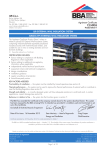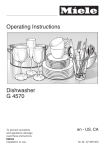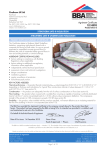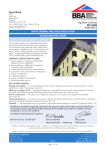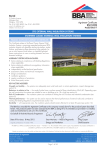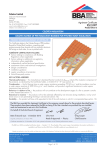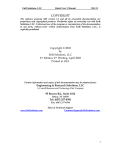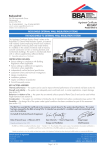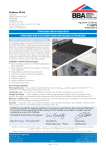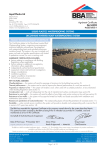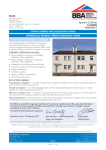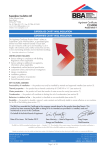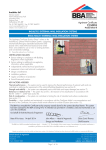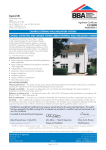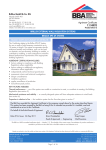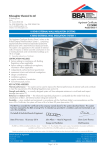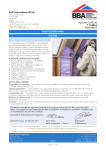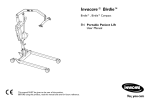Download JUB doo JUB EXTERNAL WALL INSULATION SYSTEMS JUBIZOL
Transcript
APPROVAL INSPECTION TESTING CERTIFICATION JUB d.o.o. Dol pri Ljubljani 28 SI-1262 Dol pri Ljubljani Slovenia Tel: 00 386 1 588 42 82 Fax: 00 386 1 588 42 50 TECHNICAL APPROVALS FOR CONSTRUCTION Agrément Certificate 11/4838 e-mail: [email protected] website: www.jub.eu Product Sheet 1 JUB EXTERNAL WALL INSULATION SYSTEMS JUBIZOL CR EXTERNAL WALL INSULATION SYSTEM PRODUCT SCOPE AND SUMMARY OF CERTIFICATE This Certificate relates to the Jubizol CR External Wall Insulation System, a rail-fixed system employing EPS insulation and a glassfibre mesh-reinforced render finish. It is for use above the dpc on new or existing domestic and non-domestic timber- and steel-framed buildings sheathed with a suitable exterior grade sheathing board. AGRÉMENT CERTIFICATION INCLUDES: • factors relating to compliance with Building Regulations where applicable • factors relating to additional non-regulatory information where applicable • independently verified technical specification • assessment criteria and technical investigations • design considerations • installation guidance • regular surveillance of production • formal three-yearly review. KEY FACTORS ASSESSED Strength and stability — a correctly designed system will have adequate resistance to wind loads and, in certain applications, impact damage (see section 5). Behaviour in relation to fire — as the expanded polystyrene insulation is combustible, care should be taken to ensure the adequate provision of fire barriers at junctions (see section 6). Risk of condensation — the system can contribute to limiting the risk of surface and interstitial condensation (see section 9). Thermal performance — the system can be used to improve the thermal performance of external walls or contribute to meet the Building Regulations requirements (see section 10). Durability — with appropriate care, the insulation system should remain effective for at least 30 years (see section 12). The BBA has awarded this Agrément Certificate to the company named above for the system described herein. This system has been assessed by the BBA as being fit for its intended use provided it is installed, used and maintained as set out in this Certificate. On behalf of the British Board of Agrément Date of First issue: 19 May 2011 Brian Chamberlain Greg Cooper Head of Approvals — Engineering Chief Executive The BBA is a UKAS accredited certification body — Number 113. The schedule of the current scope of accreditation for product certification is available in pdf format via the UKAS link on the BBA website at www.bbacerts.co.uk Readers are advised to check the validity and latest issue number of this Agrément Certificate by either referring to the BBA website or contacting the BBA direct. British Board of Agrément Bucknalls Lane Garston, Watford Herts WD25 9BA ©2011 Page 1 of 16 tel: 01923 665300 fax: 01923 665301 e-mail: [email protected] website: www.bbacerts.co.uk Regulations In the opinion of the BBA, the Jubizol CR External Wall Insulation System, if used in accordance with the provisions of this Certificate, will meet or contribute to meeting the relevant requirements of the following Building Regulations: The Building Regulations 2010 (England and Wales) Requirement: A1 Loading Comment: The system can sustain and transmit wind loads to the supporting structure. See sections 3.5, 5.5 and 5.10 of this Certificate. Requirement: B4(1) External fire spread Comment: Requirement: C2(b) Resistance to moisture Comment: Requirement: C2(c) Resistance to moisture The system can meet this Requirement. See sections 6.1 to 6.4 and 6.6 of this Certificate. The system provides a degree of protection against rain ingress. See sections 8.1 to 8.5 of this Certificate. Comment: The system contributes to minimising the risk of surface and interstitial condensation. See sections 9.1, 9.2, 9.5 and 9.7 of this Certificate. Requirement: L1(a)(i) Conservation of fuel and power Comment: The system can contribute to enabling a wall to meet the Target Emission Rate. See sections 10.2 and 10.3 of this Certificate. Requirement: Regulation 7 Materials and workmanship Comment: The system is acceptable. See section 12.1 and the Installation part of this Certificate. The Building (Scotland) Regulations 2004 (as amended) Regulation: 8(1)(2) Regulation: Standard: 9 1.1 2.6 2.7 3.10 3.15 Condensation Walls insulated with the system can satisfy the requirements of this Standard, with reference to clauses 3.15.1(1), 3.15.3(1) and 3.15.4(1). See sections 9.1, 9.2, 9.6 and 9.7. of this Certificate. Comment: Standard: Precipitation Walls insulated with the system will contribute to a construction satisfying this Standard, with reference to clause 3.10.1(1)(2). See sections 8.1 to 8.5 of this Certificate. Comment: Standard: Spread on external walls The system incorporates material classed as ‘combustible’ and, therefore, should not be used on walls one metre or less from the boundary, with reference to clauses 2.7.1(1)(2) and 2.7.2(2). See sections 6.1 to 6.4 and 6.6 of this Certificate. Comment: Standard: Spread to neighbouring buildings The external surface of the system has a B-s1, d0 or ‘low risk’ surface spread of flame classification, with reference to clauses 2.6.4(1)(2), 2.6.5(1) and 2.6.6(2). See sections 6.1 to 6.4 and 6.6 of this Certificate. Comment: Standard: Building standards — construction Structure The system can sustain and transmit wind loads to the structural frame. See sections 3.5, 5.5 and 5.10 of this Certificate. Comment: Standard: Fitness and durability of materials and workmanship The system can contribute to a construction satisfying the requirements of this Regulation. See sections 11.1 and 12.1 and the Installation part of this Certificate. Comment: 6.1(b) 6.2 Carbon dioxide emissions Building insulation envelope The system can contribute to enabling a wall to meet these Standards, with reference to clauses (or parts of) 6.1.1(1)(2), 6.1.2(1)(2), 6.1.3(1)(2), 6.1.4(2), 6.1.6(1), 6.1.8(2), 6.1.10(2), 6.2.1(1)(2), 6.2.3(1), 6.2.4(1), 6.2.5(1)(2), 6.2.6(2), 6.2.7(2), 6.2.11(1) and 6.2.13(2). See sections 10.2 and 10.3 of this Certificate. Comment: (1) Technical Handbook (Domestic). (2) Technical Handbook (Non-Domestic). The Building Regulations (Northern Ireland) 2000 (as amended) Regulation: B2 Fitness of materials and workmanship Comment: Regulation: B3(2) Suitability of certain materials Comment: Regulation: C4(b) Resistance to ground moisture and weather Comment: Regulation: C5 Condensation The system is acceptable. See section 12.1 and the Installation part of this Certificate. The system is acceptable. See section 11.1 of this Certificate. Walls insulated with the system can satisfy this Regulation. See sections 8.1 to 8.5 of this Certificate. Walls insulated with the system can satisfy the requirements of this Regulation. See sections 9.1, 9.2 and 9.7 of this Certificate. Comment: Regulation: Comment: D1 Stability The system can sustain and transmit wind loads to the structural frame. See sections 3.5, 5.5 and 5.10 of this Certificate. Page 2 of 16 Regulation: E5(a) External fire spread Comment: Regulation: F2(a)(i) Conservation measures The system can satisfy this Regulation. See sections 6.1 to 6.4 and 6.6 of this Certificate. The system can enable a wall to meet this Regulation. See sections 10.2 and 10.3 of this Certificate. Comment: F3(2) Comment: Target carbon dioxide Emissions Rate The system can enable a wall to meet this Regulation. See sections 10.2 and 10.3 of this Certificate. Construction (Design and Management) Regulations 2007 Construction (Design and Management) Regulations (Northern Ireland) 2007 Information in this Certificate may assist the client, CDM co-ordinator, designer and contractors to address their obligations under these Regulations. See section: 2 Delivery and site handling (2.1) of this Certificate. Non-regulatory Information NHBC Standards 2011 NHBC accepts the use of the Jubizol CR External Wall Insulation System, when installed and used in accordance with this Certificate, in relation to NHBC Standards, Part 6 Superstructure (excluding roofs), Chapters 6.2 External timber framed walls, 6.9 Curtain walling and cladding and 6.10 Light steel framed walls and floors. General This Certificate relates to the Jubizol CR External Wall Insulation System, an external wall insulation system employing EPS insulation and an acrylic render finish reinforced with a glassfibre mesh, for use on: • sheathed lightweight steel-framed structures — the system, when correctly installed, will create a 15 mm (nominal) wide drainage cavity • timber-frame constructions — a breather membrane must be secured to the sheathing and an appropriate cavity created with a nominal width of 20 mm. The system can be used on new and existing domestic and non-domestic building. Technical Specification 1 Description The Jubizol CR External Wall Insulation System, comprises a rail support system mechanically fixed to the substrate and insulation boards locking into the frame and covered with a reinforced render (see Figure 1). The system comprises: Rail support system • rails — PVC-U or aluminium rails including starter tracks, holding tracks and termination tracks, fastened to the substrate through the shims and sheathing board • vertical splines — aluminum T-sections fitting into grooves in the insulation boards to support edges • shims — PVC packers, in a range of thicknesses to maintain the design drainage cavity width • mechanical fixings — zinc-coated, carbon steel hammer-drive fixings 6 mm to 8 mm diameter with a shank length of from 50 mm to 80 mm for fixing rails and other profiles to the substrate. Insulation • insulation boards — expanded polystyrene (EPS), grooved-edge boards to BS EN 13163 : 2001 of size 500 mm by 500 mm, thickness from 50 mm to 200 mm in 10 mm increments and grade of EPS70 (classified as Euroclass E in accordance with BS EN 13501-1 : 2007, with a tensile resistance greater than 115 kPa). The boards face the drained cavity and are not foil-faced. Render • Jubizol adhesive/basecoat — adhesive mortar render supplied as a powder to which clean water is added, applied in a thickness between 3 mm and 6 mm • reinforcing mesh — glassfibre mesh with a nominal weight per unit area of 160 g·m–2 and a mesh size of 3.5 mm by 4.5 mm and width of 1 m • Jubizol Unigrund primer — a water-based acrylic slurry applied by roller to the basecoat • Jubizol Silicate or Silicone Trowelled Render — finishing coat plasters each applied to a thickness of between 1 mm and 3 mm • textured render finish — supplied pre-mixed in a range of colours. Ancillary components for render • standard profiles — for wall base, end stop, corner mesh and expansion joint • JUB corner bead with mesh — polymer-coated glassfibre mesh adhered to a perforated 90º PVC corner bar. Page 3 of 16 Ancillary components (used with the system but outside the scope of this Certificate) • breather membrane — supplied by others and used between the substrate’s sheathing board and the rail system. Used where required in steel-framed walls and in every case on timber-framed walls • deflection beads — PVC-U angle used to deflect water around openings • sealant — silicone sealant • fire stops – intumescent fire strip • mineral wool fire barrier — thickness to suit insulation width and a minimum height of 200 mm • water drainage deflection channels (for deflecting water around openings). Figure 1 Jubizol CR External wall Insulation System 2 Delivery and site handling 2.1 Components are delivered in the packaging and quantities listed in Table 1. Table 1 Component supply details Components Quantity and packaging lengths of 2500 mm lengths of 2500 mm wrapped in plastic film 1 m wide roll, 50 m length 25 kg bag (powder) 18 kg tub 20 kg tub box Aluminium horizontal base profile PVC horizontal rail profile EPS insulation Glassfibre mesh Basecoat Primer Render finishing coat Self-tapping screws 2.2 The insulation must be protected from prolonged exposure to sunlight by either storing opened packs under cover or re-covering with opaque sheeting. In addition, the insulation should be stored on a firm, clean, level base, off the ground and under cover until required for use. Care must be taken when handling the insulation boards to avoid both damage and contact with solvents or bitumen products. The boards must not be exposed to open flame or other ignition sources. 2.3 The base coat must be stored in dry conditions, off the ground, and protected from moisture. Page 4 of 16 Assessment and Technical Investigations The following is a summary of the assessment and technical investigations carried out on the Jubizol CR External Wall Insulation System. Design Considerations 3 General 3.1 The Jubizol CR External Wall Insulation System when installed in accordance with this Certificate, will improve the weather resistance of a wall and provide a decorative finish. However, it may be installed only where other routes for moisture penetration have been dealt with separately and where there are no signs of dampness on the inner surface of the wall, other than those caused solely by condensation. 3.2 When installed in accordance with this Certificate, the system is effective in reducing the thermal transmittance (U value) of the walls of new and existing buildings. However, it is essential that the detailing techniques specified in this Certificate are carried out to a high standard, if the ingress of water into the insulation is to be avoided and the full thermal benefit of the system obtained. The system can be used to prevent condensation associated with the internal wall surfaces. 3.3 The system is suitable to use on new or existing domestic and non-domestic buildings one metre or more from the boundary and where the floor level of any storey above the ground floor is up to 18 m (see section 6), and can be installed on steel- or timber-framed buildings with vertical studs. It is essential that appropriate movement joints are incorporated into the system: Steel-framed buildings • the structural frame of the building is the responsibility of the building designer and is outside the scope of the Certificate. However, the frame and sheathing must be designed to withstand the loads applied to it from the insulation system and give an acceptable resistance to pull-out of fixings (see section 5). The system must be secured to the substrate with fixings that pass through the polyamide shims to create a nominal 15 mm wide cavity between the sheathing and insulation. This drainage cavity must not be vented to the outside air to an extent that would affect the thermal performance of the system. Timber-framed buildings • the buildings should be sheathed and designed in accordance with BS EN 1995-1-1 : 2004 and BS EN 1995-1-2 : 2004 (Eurocode 5). The system should incorporate a 20 mm wide drainage cavity (see section 8.5). This cavity is slightly ventilated to the outside air and would affect the thermal performance of the insulation systems. 3.4 Existing buildings subject to the Building Regulations should have wall surfaces in accordance with section 13 Site survey and preliminary work of this Certificate. 3.5 New walls subject to the national Building Regulations should be constructed in accordance with the relevant recommendations of: • BS EN 1993-1-1 : 2005 (Eurocode 3) and other parts where appropriate • BS EN 1995-1-2 : 2004 (Eurocode 5) and other parts where appropriate. 3.6 Other new buildings not subject to regulatory requirements should also be built in accordance with the Standards identified in section 3.5. 3.7 Drainage deflection beads are incorporated into the system to deflect water present in the drainage cavity around openings, other penetrations or items that block the drainage cavity (see section 15.4). 3.8 It is essential that the insulation system is installed and maintained in accordance with the conditions set out in this Certificate. 3.9 The effect of the installation of the insulation system on the acoustic performance of a construction is also outside the scope of this Certificate. 3.10 The fixing of rainwater goods, satellite dishes, clothes lines, hanging baskets and similar items is outside the scope of this Certificate. 4 Practicability of installation The system should only be installed by installers who have been trained and approved by the Certificate holder, in accordance with their installation manual (see section 13 of this Certificate). 5 Strength and stability 5.1 Installations incorporating the insulation system can be designed to provide adequate resistance to design loads applicable in the UK. 5.2 Negative wind pressure (suction) is resisted by the bond between the render and the insulation boards, the flexural strength of the render/insulation composite, the strength of the fixing rail to insulation connection and the strength of the connection between the fixing rail and substrate wall. Page 5 of 16 5.3 Positive wind load (pressure) is transferred to the substrate wall directly via compression and bending of the render and insulation, to the fixing rail and shims and through the sheathing board to the structural frame. 5.4 Provided the substrate is suitable (see section 5.7), the fixings will effectively transfer the self-weight of the system to the substrate. The self-weight of the system including the render and the insulation is transferred to the substrate via the fixing rails. The number of rail fixings and the span between fixings should be determined by the building designer. 5.5 The wind loads on the walls should be calculated in accordance with BS EN 1991-1-4 : 2005 or BS 6399-2 : 1997. Special consideration should be given to locations with high wind-load pressure coefficients (additional fixings may be necessary). In accordance with BS EN 1990 : 2002, it is recommended that a load factor of 1.5 is used to determine the ultimate wind load to be resisted by the system. 5.6 Tests carried out on a steel-framed wall and installed with horizontal rails attached to a 12 mm thick sheathing board with steel fixings with a head diameter of 14 mm placed at a maximum of 300 mm centres and with vertical T-splines, indicated that the system can resist a design wind load of 0.67 kPa (see section 5.9). 5.7 An appropriate number of site-specific pull-out tests should be conducted on the substrate of the building to determine the characteristic pull-out resistance of the fixings. This should be determined in accordance with the guidance given in ETAG 014 : 2002, Annex D, by: • calculating the mean of the five lowest pull-out values and taking 60% of this value as the characteristic resistance. Applying a factor of safety of say 3 will give the design ultimate resistance (eg if mean of five = 1000 N, characteristic resistance = 600 N and ultimate resistance 200 N). 5.8 From tests carried out in accordance with ETAG 004 : 2000, section 5.1.4.1, it is confirmed that the bond between the basecoat and insulation is adequate to resist negative pressures likely to occur in buildings in the UK. 5.9 Assessment of structural performance for individual buildings should be carried out by a suitably qualified engineer or other appropriately qualified person to confirm that: • the substrate wall has adequate strength to resist the additional loads that may be applied as a result of installing the system ignoring any positive contribution that may occur from the insulation system • the proposed system and associated fixing layout provide adequate resistance to negative wind loads (based on the results of the site investigation) (see section 5.7). 5.10 The permitted deflection of the system incorporating steel-frame structures should be designed in accordance with BS EN 1993-1-3 : 2006, ie span/300. Deflection must be limited to prevent damage to the insulation system and the Certificate holder’s advice sought. 5.11 The designer should ensure that the fire break used with the system is fixed adequately to resist the anticipated wind loading. 5.12 It is essential that the appropriate movement joints and expansion joints are incorporated into the construction to accommodate the differential movement, for example, expansion and contraction due to variation of temperature and moisture levels between elements of the substrate. This is to ensure substrate movement does not damage the insulation system. Impact loading 5.13 Hard body impact tests were carried out generally in accordance with ETAG 004 : 2000, clauses 5.1.3.3, 5.1.3.3.1 and 5.1.3.3.2. It is recommended that use of the system is restricted to category II as defined in ETAG 004 : 2000, section 6.1.3.3, or category E(1) as defined in BS 8200 : 1985, Table 2. (1) Above zone of normal impacts from people but liable to impacts from thrown or kicked objects, eg 1.5 m to 6 m above pedestrian or floor level in areas readily accessible to public and others with little incentive to exercise care. 6 Behaviour in relation to fire General 6.1 The surface spread of flame classification of the external surface of the system is given in Table 3. The system, therefore, may be used in accordance with the provision of: England and Wales — Approved Document B, Volume 1, paragraph 8.4, and Volume 2, paragraph 12.6 (see also Volume 2, Diagram 40) Scotland — Mandatory Standards 2.6 and 2.7, clauses 2.6.1(1)(2) to 2.6.5(1)(2), 2.6.6(2), 2.6.7(2), 2.7.1(1)(2) and 2.7.2(2) respectively, and Annexes 2.C(1) and 2.E(2) Northern Ireland — Technical Booklet E, paragraph 4.3 (see also Diagram 4.1). (1) Technical Handbook (Domestic). (2) Technical Handbook (Non-Domestic). Table 3 Surface spread of flame classification System Class according to BS EN 13501-1 : 2007 B-s1, d0 Jubizol render system(1) (1) Jubizol Basecoat, reinforced mesh, primer and Jubizol texture render finish. Page 6 of 16 6.2 This rating applies to the light colours in the range covered by the Certificate. 6.3 The insulation materials in isolation are classified as combustible (EPS) and must be used in accordance with the relevant Building Regulations. 6.4 The system is restricted for use in buildings less than 18 m height. The document listed in section 6.1 gives full details of permissible heights and boundary conditions of domestic and non-domestic buildings and relevant guidance with regard external wall insulation with render surfaces. 6.5 The fire-resistance performance of a wall incorporating the system is outside the scope of this Certificate and can only be determined from tests performed by a UKAS accredited laboratory for the test concerned. 6.6 The system covered by this Certificate incorporates cavities. Therefore any cavities present within the system, such as those formed between the external wall insulation system and the substrate, must have an appropriate fire stop or cavity barrier. This relates to the requirement for fire barriers to limit the risk of fire spread between floors in buildings in accordance with the Building Regulations. Guidance concerning this is given in BRE report (BR 135 : 2007) Fire Performance of External Insulation for Walls of Multi-storey Buildings. Further details are given in: England and Wales — Approved Document B, Sections 5(1) and 8(2) Scotland — Mandatory Standard 2.2(3)(4) Northern Ireland — Technical Booklet F, Section 3. (1) (2) (3) (4) Dwellinghouses. Buildings other than dwellinghouses. Technical Handbook (Domestic). Technical Handbook (Non-Domestic). 7 Proximity of flues and appliances When the system is installed in close proximity to certain flue pipes, the relevant provisions of the national Building Regulations should be met: England and Wales — Approved Document J Scotland — Mandatory Standard 3.19 Northern Ireland — Technical Booklet L. 8 Rain penetration 8.1 The final weather resistance of the building is dependent upon the efficient positioning and sealing of all joints. Guidance in BRE report (BR 262 : 2002) Thermal insulation: avoiding risks should be followed in that the designer should select a construction appropriate to the local wind-driven rain index, paying due regard to the design detailing, workmanship and materials to be used. Additional guidance can be found in: England and Wales — Approved Document C, Section 5 Scotland — Mandatory Standard 3.10(1)(2) Northern Ireland — Technical Booklet C, Section 2. (1) Technical Handbook (Domestic). (2) Technical Handbook (Non-Domestic). 8.2 The system has been assessed for use in sheltered areas when installed onto a timber or light-steel framework. 8.3 In all cases care, should be taken to ensure that walls are weathertight prior to application of the system, and should only be installed where there are no signs of dampness on the inner surface of the substrate other than those caused solely by condensation. 8.4 Where used, the sheathing board substrate must be of a suitable exterior grade with appropriately sealed joints, sealed penetrations and vapour control layers where required. Examples of relevant detailing for external wall insulation systems with a drainage cavity are given in SCI Publication P343 Insulated Render Systems Used With Light Steel Framing (Steel Construction Institute, 2006) and, for timber-framed structures, TRADA Technology publications. 8.5 The designer should check that the windows, doorset, flashing and other similar items have been specifically designed for this use. Particular attention should be paid to the prevention of water ingress. When installing the system in a timber-framed wall structure, a cavity should be provided to ensure a passive flow of air through the opening at the base of the system to avoid condensation risk due to moisture penetration. 8.6 At the tops of walls, the system should be protected by an adequate overhang or other detail designed for use with this type of system (see Figure 7). 9 Risk of condensation 9.1 When using the system, consideration must be given to the overall design to minimise the risk of condensation, and the recommendations of BS 5250 : 2002 should be followed — the values given in sections 9.4 and 9.5 may be used. 9.2 Designers must ensure that an appropriate condensation risk analysis has been carried out for all parts of the construction, including at junctions between the insulation systems, windows, and the sheathing board, and the structural frame, and at other openings and penetrations to ensure condensation does not occur at the surface or within. Page 7 of 16 9.3 Dynamic condensation modelling can be carried out for light-steel and timber-framed constructions to assess the likelihood of moisture accumulating within the construction over the design life of the building. 9.4 The resistivity of the EPS insulation boards can be taken as 300 MNs·g–1·m–1. Surface condensation 9.5 Walls will limit the risk of surface condensation adequately when the thermal transmittance (U value) does not exceed 0.7 W·m–2·K–1 at any point and the junctions with other elements and openings comply with section 7.5. 9.6 Walls will adequately limit the risk of surface condensation when the thermal transmittance (U value) does not exceed 1.2 W·m–2·K–1 at any point. Guidance may be obtained from BS 5250 : 2002, Section 8, and BRE report (BR 262 : 2002) Thermal insulation : avoiding risks. Interstitial condensation 9.7 Weathertight walls incorporating the insulation system will adequately limit the risk of interstitial condensation when they are designed and constructed in accordance with BS 5250 : 2002, Section 8 and Annex D. 9.8 If the insulation system is to be used on the external walls of rooms expected to have continuous high humidities, care must be taken in the design of the rooms to avoid possible problems from the formation of interstitial condensation. 9.9 Care must be taken to ensure the building is adequately sealed and ventilation is in place to help prevent surface condensation forming on the internal face of the sheathing board or the surface of the steel or timber frame. 10 Thermal performance 10.1 Calculations of thermal transmittance (U value) must include the effect of the type of cavity included within the system and should be carried out in accordance with BS EN ISO 6946 : 2007 and BRE report (BR 443 : 2006) Conventions for U-value calculations, using the insulation manufacturer’s declared thermal conductivity (λ90/90 value) of the insulation of 0.038 W·m–1·K–1. 10.2 The U value of a completed wall will depend on the selected insulation thickness, the degree of ventilation to the cavity, the fixing method and the insulating value of the substrate and its internal finish. Calculated U values for example constructions with EPS insulation (EPS70) are given in Tables 4 and 5. Table 4 Insulation thickness required to achieve some typical U values (steel-framed with fixing rail) (1)(2) U value(3) (W·m–2·K–1) Insulation thickness(4) (mm) 0.19 190 180 130 120 110 0.26 0.28 0.30 (1) Wall construction: • 12.5 mm plasterboard (λ = 0.21 W·m–1·K–1) • 100 mm uninsulated steel C-section [0.28% metal studs with 50 mm flanges (λ = 50 W·m–1·K–1)] • 15 mm cavity spacer (drainage cavity according to BS EN ISO 6946 : 2007) • PVC fixing rail (λ = 0.17 W·m–1·K–1) • EPS insulation (λ = 0.038 W·m–1·K–1) • 8 mm thick render (λ = 1 W·m–1·K–1). (2) Based upon calculations in accordance with BS EN ISO 6946 : 2007. (3) The cavity has been considered unventilated. (4) Based upon incremental insulation thicknesses of 10 mm. Page 8 of 16 Table 5 Insulation thickness required to achieve some typical U values (timber-framed with fixing rail) (1)(2) U value(3) (W·m–2·K–1) Insulation thickness (4) (mm) 0.19 0.26 0.28 0.30 240 170 150 140 (1) Wall construction: • 12.5 mm plasterboard (λ = 0.21 W·m–1·K–1) • timber-framed wall (15% timber) (λ = 0.13 W·m–1·K–1) • 15 mm cavity spacer (drainage and ventilated cavity according to BS EN ISO 6946 : 2007, with opening area of 750 mm2·m–1) • PVC fixing rail (λ = 0.17 W·m–1·K–1) • EPS insulation (λ = 0.038 W·m–1·K–1) • 8 mm thick render (λ = 1 W·m–1·K–1). (2) Based upon calculations in accordance with BS EN ISO 6946 : 2007. (3) The cavity has been considered slightly ventilated. (4) Based upon incremental insulation thicknesses of 10 mm. 10.3 The system can maintain, or contribute to maintaining, continuity of thermal insulation at junctions between external walls and openings (see Figure 2). Detailed guidance in this respect and on limiting heat loss by air infiltration can be found in: England and Wales — Approved Documents to Part L and, for new thermal elements to existing buildings, Accredited Construction Details (version 1.0) (for new-build, see also SAP 2009, Appendix K, and the iSBEM User Manual). Scotland — Accredited Construction Details (Scotland) Northern Ireland — Accredited Construction Details (version 1.0). Figure 2 Junction details 10.4 Care must be taken to ensure an appropriate thickness of insulation is used, particularly at points such as junctions between floors and walls and at window and door reveals, to avoid thermal bridging and reduce the risk of condensation forming at these points. Items such as windows and doors should be selected taking into account the thickness of insulation required at the reveals to help prevent condensation forming at these junctions. Page 9 of 16 11 Maintenance and repair 11.1 Regular checks should be made on the installed insulation system, particularly at joints with other elements, to ensure that ingress of water does not occur. This should verify that architectural details for shedding water clear of the building are present and functioning, and that external plumbing fitments are in good condition. Maintenance schedules should include the replacement and resealing of joints, for example between the insulation systems and window and door frames. The interval between inspections should be considered for each building taking into consideration such factors as the building location and height. Necessary repairs should be effected immediately and the sealant at joints at window and door frames replaced whenever required. 11.2 The designer should ensure suitable access is available to enable maintenance inspections to take place safely. 11.3 Damaged areas must be repaired using the appropriate Jubizol system components and the procedures detailed in the Certificate holder’s technical literature. The Certificate holder should be consulted on the appropriate measures for a particular installation. 11.4 Textured finishes may become soiled in time, the rate depending on the product chosen, initial colour, the degree of exposure, level of atmospheric pollution and the design and detailing of the wall. The Certificate holder’s advice should be sought for the restoration of the surface finish. 12 Durability 12.1 The system should remain effective for at least 30 years, provided any damage to the surface finish is repaired immediately, and regular maintenance is undertaken (see section 11). 12.2 The external surface of the wall may become discoloured with time, the rate depending on the initial colour, the degree of exposure and atmospheric pollution. In common with traditional renders, dependent upon pigment colour and type, discoloration by algae and lichens may occur in wet areas. 12.3 Render containing cement may be subject to lime bloom. The occurrence of this may be reduced by avoiding application in adverse weather conditions. The effect is transient and is less noticeable on lighter colours. Installation 13 General Application of the system, within the context of this Certificate, must be carried out by installers approved by the Certificate holder. A Certificate holder approved installer is a company which: • employs operatives who have been trained and approved by the Certificate holder to install the system and has operatives who, upon completion of their training, have been issued with an appropriate identification card by the Certificate holder • has undertaken to comply with the Certificate holder’s application procedure, containing the requirement for each application team to include at least one member with an identification card • agrees to be subject to supervision by the Certificate holder, including site inspections. 14 Site survey and preliminary work 14.1 Before application of the insulation system, a pre-installation survey of the property is carried out to determine whether repairs are required to the sheathing board or structural frame. Repairs should be carried out before installation commences. 14.2 Surfaces on which the render system is to be installed should be sound, clean, and free from loose material. The flatness of surfaces must be checked; this may be achieved by using a straight-edge spanning the storey height. Any excessive irregularities, ie greater than 10 mm, must be made good prior to installation. 14.3 A specification is prepared for each project, incorporating details such as: • position of starter tracks, cavity spacer tracks, and render beads • position and amount of reinforcing scrim • additional reinforcing scrim at corners of openings • detailing around windows, doors and at eaves • dpc level • location and type of weather seals to be used and location of water deflection channels • areas where suitable silicone sealants must be used • position of fire barriers. 14.4 On existing buildings, purpose-made sills must be fitted to extend beyond the finished face of the system. New buildings should incorporate suitably deep sills. 14.5 Where appropriate, external plumbing should be removed and alterations made to underground drainage to accommodate its repositioning on the finished face of the insulation system. Page 10 of 16 15 Procedure General 15.1 Application of the system is carried out in accordance with the Certificate holder’s current installation instructions. 15.2 Application of coating materials must not be carried out at temperatures below 5°C or above 35°C, nor if exposure to frost is likely, and the coating must be protected from rapid drying. Weather conditions, therefore, should be monitored to ensure correct curing conditions. 15.3 All rendering should be in accordance with the relevant recommendations of BS EN 13914-1 : 2005 and BS EN 13914-2 : 2005. Positioning and securing insulation boards or slabs 15.4 The base profile is secured to the sheathing above the damp-proof course using the appropriate profile fixings at a maximum of 300 mm centres. Drainage deflection channels are mechanically fixed over all window and door openings and horizontal and vertical fire barriers are installed following the designer’s instructions. 15.5 The horizontal cavity spacer rails are fixed to the sheathing at a maximum of 600 mm centres. Rails may need packing to ensure they are true to line and level. The fixings pass through the packing pieces and into the substrate. When required, fire breaks or cavity barriers should be incorporated into the system in accordance with the manufacturer’s installation instructions. 15.6 The first insulation board is positioned onto the base profile, and is used to position the first horizontal rail. The fixing rail slots into the pre-cut groove in the insulation board. The level is checked and the rail is positioned away from the substrate using a specially designed 15 mm spacer. It is important that the fixing rail fits tightly and locates fully into the groove in the insulation; it should not be forced into position. 15.7 Once the horizontal fixing rails are in position and the insulation board is placed onto the fixing rail, the vertical fixing rails are positioned and fixed to the horizontal rails and EPS grooves. The next insulation board is slotted into place. It is important to ensure that the fixing rails fit securely into the grooved insulation and that the insulation boards are tightly butted together, particularly at corners. 15.8 Installation continues as described above, with the level of the fixing rails and the cavity being checked at regular intervals to ensure a uniform level is maintained. A typical layout of the insulation boards and reinforcement at the corner of the windows is shown in Figure 3. Figure 3 Additional mesh reinforcement at windows 15.9 Special fixing rails are used to ensure the insulation fits around opening details such as doors and windows. Where necessary the insulation can be cut and grooved on site using tools supplied by the Certificate holder. Movement joints and render beads 15.10 The system incorporates provision for movement joints. 15.11 Expansion beads are fixed vertically in predetermined positions where necessary, according to the installation specification and the individual requirements of each job. Page 11 of 16 Basecoat 15.12 Prior to the render coat, seals are applied where required and a bead of silicone sealant is applied to window and door frames, overhanging eaves, gas and electric meter boxes, wall vents or where the render abuts any other building material or surface. 15.13 The basecoat render is prepared by combining the contents of a 25 kg bag with between 4 and 5 litres of clean water and thoroughly paddle-mixing for approximately five minutes or until the correct workability is achieved. 15.14 The basecoat is trowelled or pumped onto the surface of the insulation boards to a thickness of between 3 mm and 6 mm, ensuring it is butted against details (eg under window sills). The surface should be finished smooth, without depressions or other irregularities. Reinforcement 15.15 The reinforcing mesh is embedded into the surface of the basecoat and trowelled over to completely cover the mesh. All the rendered surfaces must be reinforced and joints in the mesh overlapped by at least 100 mm. 15.16 Additional reinforcement is required around openings and at corners (see Figure 3). Angle beads and stop beads are positioned in accordance with the Certificate holder’s installation instructions. 15.17 The drying period of any render will depend on weather conditions. However, the basecoat must be left to harden for at least two days before applying the relevant finish. Finishing coat 15.18 The finishing coat render is applied to a thickness of between 1 mm and 3 mm depending on grain size. A straight edge can be used to help ensure a flat surface and specialised tools, supplied by the Certificate holder, can be used to create the desired finish. 15.19 The cavity rail fire break detail should be incorporated between the second and third floors to coincide with slab levels, and at subsequent floors above (see Figure 4). Figure 4 Fire break details 15.20 Care should be taken at the tops of walls and around openings such as windows and doors to ensure that they are adequately protected by a suitable overhang and are sufficiently sealed with a purpose-made flashing (see Figures 5 and 6). Page 12 of 16 Figure 5 Details around window openings and projections Page 13 of 16 Figure 6 Details of reveal around window openings 16 Site practice It is essential that appropriate site surveillance is in place to ensure the detailing is carried out to the correct level. Additionally, the installation of the insulation systems should be checked by the person supervising the works at the end of each relevant stage of the installation. Information from the Certificate holder should be sought on this subject. Technical Investigations 17 Tests and investigations 17.1 Tests were carried out in accordance with ETAG 004 : 2004 to determine the resistance to wind uplift. 17.2 Tests were carried out in accordance with MOAT No 43 : 1987 to determine the resistance to soft body impacts. 17.3 An examination was made of data relating to adequacy of the fixing system and durability of finish. 17.4 The practicability of installation and the effectiveness of typical details were examined. 17.5 An evaluation of ETA-04/0007 was undertaken as a basis for the initial assessment. 17.6 Calculations were assessed in connection with the structural performance of the system. Page 14 of 16 Bibliography BS 5250 : 2002 Code of practice for control of condensation in buildings BS 5950-5 : 1998 Structural use of steelwork in building — Code of practice for design of cold formed thin gauge sections BS 6399-2 : 1997 Loading for buildings — Code of practice for wind loads BS 8000-10 : 1995 Workmanship on building sites — Code of practice for plastering and rendering BS 8200 : 1985 Code of practice for design of non-loadbearing external vertical enclosures of buildings BS 8414-2 : 2005 Fire performance of external cladding systems — Test method for non-loadbearing external cladding systems fixed to and supported by a structural steel frame BS EN 634-2 : 2007 Cement bonded particleboards — Specification — Requirements for OPC bonded particleboards for use in dry, humid and exterior conditions BS EN 1990 : 2002 Eurocode — Basis of structural design BS EN 1991-1-4 : 2005 Eurocode 1 : Actions on structures — General actions — Wind actions BS EN 1993-1-1 : 2005 Eurocode 3 : Design of steel structures — General rules and rules for buildings BS EN 1993-1-2 : 2005 Eurocode 3 : Design of steel structures — General rules — Structural fire design BS EN 1993-1-3 : 2006 Eurocode 3 : Design of steel structures — General rules — Supplementary rules for coldformed members and sheeting BS EN 1995-1-1 : 2004 Eurocode 5 : Design of timber structures — General — Common rules and rules for buildings BS EN 10326 : 2004 Continuously hot-dip coated strip and sheet of structural steels — Technical delivery conditions BS EN 13163 : 2001 Thermal insulation products for buildings — Factory made products of expanded polystyrene (EPS) — Specification BS EN 13501-1 : 2007 Fire classification of construction products and building elements — Classification using test data from reaction to fire tests BS EN 13914-1 : 2005 Design, preparation and application of external rendering and internal plastering — External rendering BS EN 13914-2 : 2005 Design, preparation and application of external rendering and internal plastering — Design considerations and essential principles for internal plastering BS EN ISO 6946 : 1997 Building components and building elements — Thermal resistance and thermal transmittance — Calculation method ETAG 004 : 2000 Guideline for European Technical Approval of External Thermal Insulation Composite Systems with Rendering ETAG 014 : 2002 Guideline for European Technical Approval of Plastic Anchors for Fixing of External Thermal Insulation Composite Systems with Rendering MOAT No 22 : 1988 UEAtc Directives for the Assessment of External Insulation Systems for Walls (Expanded Polystyrene Insulation Faced with a Thin Rendering) MOAT No 43 : 1987 UEAtc Directives for Impact Testing Opaque Vertical Building Components Page 15 of 16 Conditions of Certification 18 Conditions 18.1 This Certificate: • relates only to the product/system that is named and described on the front page • is granted only to the company, firm or person named on the front page — no other company, firm or person may hold or claim any entitlement to this Certificate • is valid only within the UK • has to be read, considered and used as a whole document — it may be misleading and will be incomplete to be selective • is copyright of the BBA • is subject to English law. 18.2 Publications and documents referred to in this Certificate are those that the BBA deems to be relevant at the date of issue or re-issue of this Certificate and include any: Act of Parliament; Statutory Instrument; Directive; Regulation; British, European or International Standard; Code of Practice; manufacturers’ instructions; or any other publication or document similar or related to the aforementioned. 18.3 This Certificate will remain valid for an unlimited period provided that the product/system and the manufacture and/or fabrication including all related and relevant processes thereof: • are maintained at or above the levels which have been assessed and found to be satisfactory by the BBA • continue to be checked as and when deemed appropriate by the BBA under arrangements that it will determine • are reviewed by the BBA as and when it considers appropriate. 18.4 In granting this Certificate, the BBA is not responsible for: • the presence or absence of any patent, intellectual property or similar rights subsisting in the product/system or any other product/system • the right of the Certificate holder to manufacture, supply, install, maintain or market the product/system • individual installations of the product/system, including the nature, design, methods and workmanship of or related to the installation • the actual works in which the product/system is installed, used and maintained, including the nature, design, methods and workmanship of such works. 18.5 Any information relating to the manufacture, supply, installation, use and maintenance of this product/system which is contained or referred to in this Certificate is the minimum required to be met when the product/system is manufactured, supplied, installed, used and maintained. It does not purport in any way to restate the requirements of the Health & Safety at Work etc Act 1974, or of any other statutory, common law or other duty which may exist at the date of this Certificate; nor is conformity with such information to be taken as satisfying the requirements of the 1974 Act or of any statutory, common law or other duty of care. In granting this Certificate, the BBA does not accept responsibility to any person or body for any loss or damage, including personal injury, arising as a direct or indirect result of the manufacture, supply, installation, use and maintenance of this product/system. British Board of Agrément Bucknalls Lane Garston, Watford Herts WD25 9BA ©2011 Page 16 of 16 tel: 01923 665300 fax: 01923 665301 e-mail: [email protected] website: www.bbacerts.co.uk
















